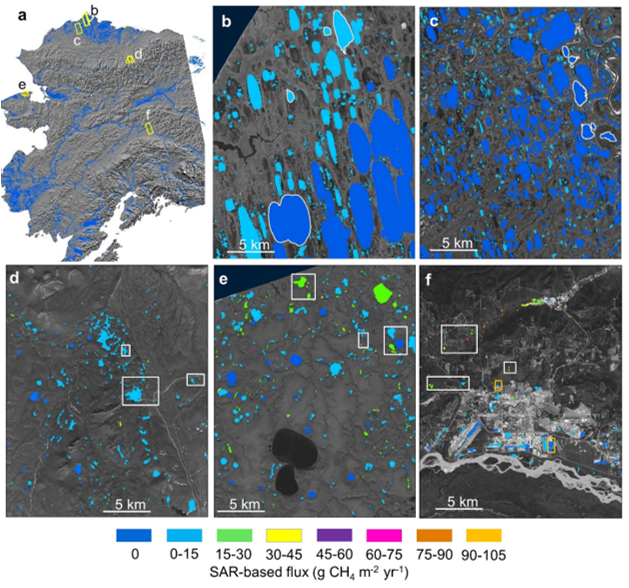ABoVE: SAR-based Methane Ebullition Flux from Lakes, Five Regions, Alaska, 2007-2010
This Arctic-Boreal Vulnerability Experiment (ABoVE) dataset provides Synthetic Aperture Radar (SAR) estimates of lake-source methane ebullition flux (mg CH4/m2/d) for thousands of lakes in five regions across Alaska. The study regions include the Atqasuk, Barrow Peninsula, Fairbanks, northern Seward Peninsula, and Toolik. These data are significant providing the first landscape-scale estimates of methane ebullition from lakes on a lake-by-lake basis and serve as a baseline for future methane estimates.
L-band SAR backscatter values for early winter lake ice scenes were collected from 2007 to 2010 over 5,143 lakes using the Phased Array type L-band Synthetic Aperture Radar (PALSAR) instrument on the Advanced Land Observing Satellite (ALOS-1) satellite. Combined with field measurements of methane ebullition from 48 study lakes across the five regions, a volumetric flux estimate for each lake was estimated. Mean methane gas-fractions from each region were applied to the SAR-based volumetric fluxes to obtain an estimate of methane ebullition mass flux per lake.
ABoVE is a NASA Terrestrial Ecology Program field campaign being conducted in Alaska and western Canada, for 8 to 10 years, starting in 2015. Research for ABoVE links field-based, process-level studies with geospatial data products derived from airborne and satellite sensors, providing a foundation for improving the analysis, and modeling capabilities needed to understand and predict ecosystem responses to, and societal implications of, climate change in the Arctic and Boreal regions. See all ORNL DAAC data from ABoVE.
Data Citation: Engram, M.J., K.W. Anthony, and F.J. Meyer. 2020. ABoVE: SAR-based Methane Ebullition Flux from Lakes, Five Regions, Alaska, 2007-2010. ORNL DAAC, Oak Ridge, Tennessee, USA. https://doi.org/10.3334/ORNLDAAC/1790

